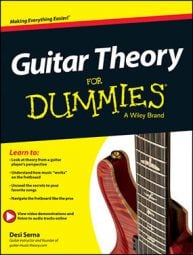On the guitar, sometimes a song’s chord progression is moved, or transposed, up or down by a particular interval for a section; the song’s tonic changes by the same interval. Here is an example of a transposed chord progression that starts out in the key of C before transposing and reproducing the same chord progression a whole step higher in the key of D.
![[Credit: Illustration courtesy of Desi Serna]](https://www.dummies.com/wp-content/uploads/419091.image0.jpg)
You can see and hear how to transpose a chord progression at Chapter 8, Video Clip 15: Transposing a Progression.
“My Girl” by The Temptations changes keys in the same way as this example. This type of key change is sometimes called the truck driver modulation because it feels like the song has shifted into a higher gear. It often occurs at the end of a song to make the final repeated chorus sound different and climactic.
Chord transpositions aren’t always a whole step. In fact, transpositions can take many shapes and sizes:
A transposition may be only a half step, as is the case in “Crazy” by Patsy Cline, which modulates from Bf to B; “Crimson and Clover” by Tommy James and the Shondells, which modulates from B to C; and “Surrender” by Cheap Trick, which modulates from B to C.
A transposition may be a step and a half, as you see in “To Be with You” by Mr. Big, “Livin’ on a Prayer” by Bon Jovi, and “Play That Funky Music” by Wild Cherry, which all modulate from E to G.
A transposition may be short-lived. “Are You Gonna Go my Way” by Lenny Kravitz briefly modulates from E to G at 00:46 by moving up three frets and then moves back down to E at 00:54. “Funk #49” by the James Gang has an A minor pentatonic riff that starts at 0:37, moves up a whole step to B minor at 0:38, and returns to A at 0:48.
More than one transposition may occur in the same song. “Play That Funky Music” by Wild Cherry, “You Really Got Me” by The Kinks, “Pinball Wizard” by The Who, and “California Girls” by The Beach Boys all touch on three or more keys.
When a song modulates up or down a half step, whole step, or more, it’s easy to follow on guitar. Usually, you simply need to move the barre chords and/or scale patterns up or down.
How you describe a key change is a matter of preference. One way to describe chord transpositions is by their intervals. For instance, in some of the previous examples, the progression modulates by three half steps, or three frets on the guitar, so you can say that each song modulates up a minor 3rd. Similarly, “You Really Got Me” modulates up a 4th from A to D at one point.
Take a look at a few more examples of transposing a chord progression:
The verses to “I Walk the Line” by Johnny Cash all use a I-IV-V chord progression. You first hear it in F, and then the song modulates to Bf and then Ef. Each key repeats the same progression, and each modulation is up a perfect 4th. The music then modulates back down to the key of Bf and eventually returns to the original key of F.
“My Generation” by The Who moves through three key changes from G, up a tone to A, up a semitone to Bf, and up another tone to finish in C. “Wrong Way” by Sublime moves through E, A, Fs, and B. Both of these songs use I-fVII chord changes in each key.
John Mellencamp’s “I Need a Lover” is built from a I-V-IV-V chord progression in the keys of Bf, Fs, B, and E, all before the verse even starts! The song finally settles in the key of Fs for most of the verses and choruses, but it modulates up to the key of A at the 4:35 mark before ending.

